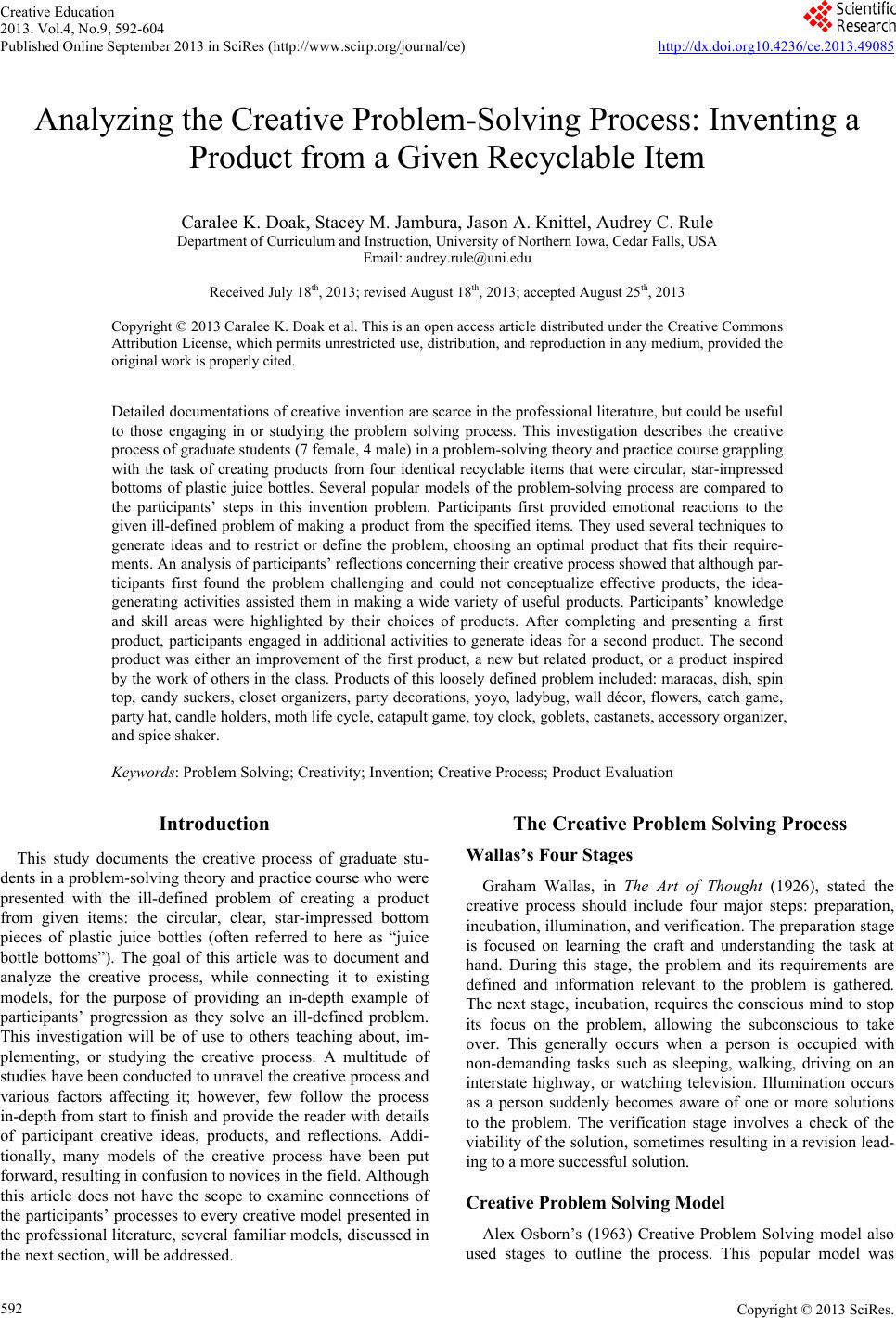 Creative Education 2013. Vol.4, No.9, 592-604 Published Online September 2013 in SciRes (http://www.scirp.org/journal/ce) http://dx.doi.org10.4236/ce.2013.49085 Copyright © 2013 SciRe s . 592 Analyzing the Creative Problem-Solving Process: Inventing a Product from a Given Recyclable Item Caralee K. Doak, Stacey M. Jambura, Jason A. Knittel, Audrey C. Rule Department of Curriculum and Instruction, University of Northern Iowa, Cedar Falls, USA Email: audrey.rule@uni.edu Received July 18th, 2013; revised August 18th, 2013; accepted August 25th, 2013 Copyright © 2013 Caralee K. Doak et al. This is an open access article distributed under the Creative Commons Attribution License, which permits unrestricted use, distribution, and reproduction in any medium, provided the original work is properly cited. Detailed documentations of creative invention are scarce in the professional literature, but could be useful to those engaging in or studying the problem solving process. This investigation describes the creative process of graduate students (7 female, 4 male) in a problem-solving theory and practice course grappling with the task of creating products from four identical recyclable items that were circular, star-impressed bottoms of plastic juice bottles. Several popular models of the problem-solving process are compared to the participants’ steps in this invention problem. Participants first provided emotional reactions to the given ill-defined problem of making a product from the specified items. They used several techniques to generate ideas and to restrict or define the problem, choosing an optimal product that fits their require- ments. An analysis of participants’ reflections concerning their creative process showed that although par- ticipants first found the problem challenging and could not conceptualize effective products, the idea- generating activities assisted them in making a wide variety of useful products. Participants’ knowledge and skill areas were highlighted by their choices of products. After completing and presenting a first product, participants engaged in additional activities to generate ideas for a second product. The second product was either an improvement of the first product, a new but related product, or a product inspired by the work of others in the class. Products of this loosely defined problem included: maracas, dish, spin top, candy suckers, closet organizers, party decorations, yoyo, ladybug, wall décor, flowers, catch game, party hat, candle holders, moth life cycle, catapult game, toy clock, goblets, castanets, accessory organizer, and spice shaker. Keywords: Problem Solving; Creativity; Invention; Creative Process; Product Evaluation Introduction This study documents the creative process of graduate stu- dents in a problem-solving theory and practice course who were presented with the ill-defined problem of creating a product from given items: the circular, clear, star-impressed bottom pieces of plastic juice bottles (often referred to here as “juice bottle bottoms”). The goal of this article was to document and analyze the creative process, while connecting it to existing models, for the purpose of providing an in-depth example of participants’ progression as they solve an ill-defined problem. This investigation will be of use to others teaching about, im- plementing, or studying the creative process. A multitude of studies have been conducted to unravel the creative process and various factors affecting it; however, few follow the process in-depth from start to finish and provide the reader with details of participant creative ideas, products, and reflections. Addi- tionally, many models of the creative process have been put forward, resulting in confusion to novices in the field. Although this article does not have the scope to examine connections of the participants’ processes to every creative model presented in the professional literature, several familiar models, discussed in the next section, will be addressed. The Creative Problem Solving Process Wallas’s Four Stages Graham Wallas, in The Art of Thought (1926), stated the creative process should include four major steps: preparation, incubation, illumination, and verification. The preparation stage is focused on learning the craft and understanding the task at hand. During this stage, the problem and its requirements are defined and information relevant to the problem is gathered. The next stage, incubation, requires the conscious mind to stop its focus on the problem, allowing the subconscious to take over. This generally occurs when a person is occupied with non-demanding tasks such as sleeping, walking, driving on an interstate highway, or watching television. Illumination occurs as a person suddenly becomes aware of one or more solutions to the problem. The verification stage involves a check of the viability of the solution, sometimes resulting in a revision lead- ing to a more successful solution. Creative Problem Solving Model Alex Osborn’s (1963) Creative Problem Solving model also used stages to outline the process. This popular model was 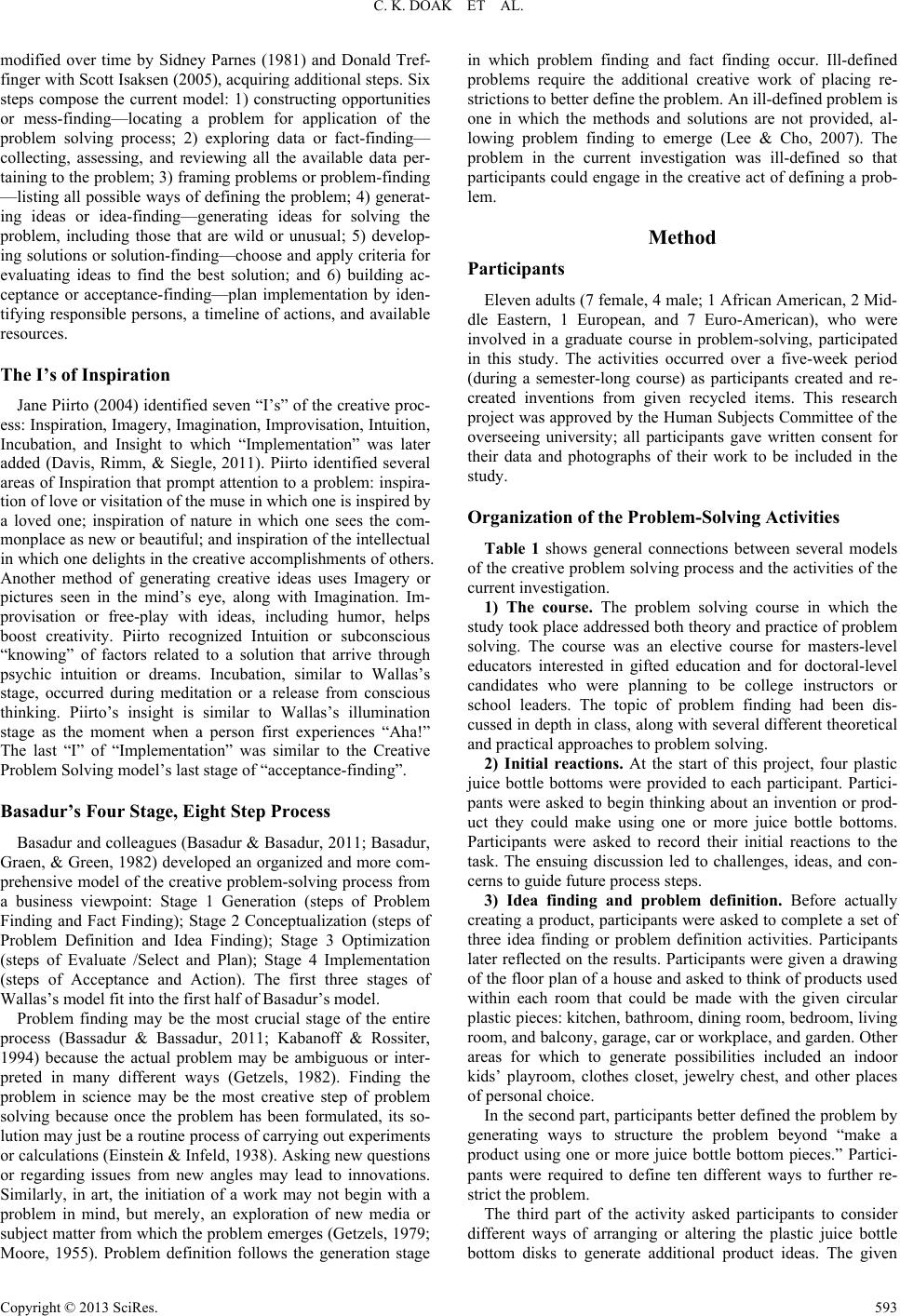 C. K. DOAK ET AL. Copyright © 2013 SciRe s . 593 modified over time by Sidney Parnes (1981) and Donald Tref- finger with Scott Isaksen (2005), acquiring additional steps. Six steps compose the current model: 1) constructing opportunities or mess-finding—locating a problem for application of the problem solving process; 2) exploring data or fact-finding— collecting, assessing, and reviewing all the available data per- taining to the problem; 3) framing problems or problem-finding —listing all possible ways of defining the problem; 4) generat- ing ideas or idea-finding—generating ideas for solving the problem, including those that are wild or unusual; 5) develop- ing solutions or solution-finding—choose and apply criteria for evaluating ideas to find the best solution; and 6) building ac- ceptance or acceptance-finding—plan implementation by iden- tifying responsible persons, a timeline of actions, and available resources. The I’s of Inspiration Jane Piirto (2004) identified seven “I’s” of the creative proc- ess: Inspiration, Imagery, Imagination, Improvisation, Intuition, Incubation, and Insight to which “Implementation” was later added (Davis, Rimm, & Siegle, 2011). Piirto identified several areas of Inspiration that prompt attention to a problem: inspira- tion of love or visitation of the muse in which one is inspired by a loved one; inspiration of nature in which one sees the com- monplace as new or beautiful; and inspiration of the intellectual in which one delights in the creative accomplishments of others. Another method of generating creative ideas uses Imagery or pictures seen in the mind’s eye, along with Imagination. Im- provisation or free-play with ideas, including humor, helps boost creativity. Piirto recognized Intuition or subconscious “knowing” of factors related to a solution that arrive through psychic intuition or dreams. Incubation, similar to Wallas’s stage, occurred during meditation or a release from conscious thinking. Piirto’s insight is similar to Wallas’s illumination stage as the moment when a person first experiences “Aha!” The last “I” of “Implementation” was similar to the Creative Problem Solving model’s last stage of “acceptance-finding”. Basadur’s Four Stage, Eight Step Process Basadur and colleagues (Basadur & Basadur, 2011; Basadur, Graen, & Green, 1982) developed an organized and more com- prehensive model of the creative problem-solving process from a business viewpoint: Stage 1 Generation (steps of Problem Finding and Fact Finding); Stage 2 Conceptualization (steps of Problem Definition and Idea Finding); Stage 3 Optimization (steps of Evaluate /Select and Plan); Stage 4 Implementation (steps of Acceptance and Action). The first three stages of Wallas’s model fit into the first half of Basadur’s model. Problem finding may be the most crucial stage of the entire process (Bassadur & Bassadur, 2011; Kabanoff & Rossiter, 1994) because the actual problem may be ambiguous or inter- preted in many different ways (Getzels, 1982). Finding the problem in science may be the most creative step of problem solving because once the problem has been formulated, its so- lution may just be a routine process of carrying out experiments or calculations (Einstein & Infeld, 1938). Asking new questions or regarding issues from new angles may lead to innovations. Similarly, in art, the initiation of a work may not begin with a problem in mind, but merely, an exploration of new media or subject matter from which the problem emerges (Getzels, 1979; Moore, 1955). Problem definition follows the generation stage in which problem finding and fact finding occur. Ill-defined problems require the additional creative work of placing re- strictions to better define the problem. An ill-defined problem is one in which the methods and solutions are not provided, al- lowing problem finding to emerge (Lee & Cho, 2007). The problem in the current investigation was ill-defined so that participants could engage in the creative act of defining a prob- lem. Method Participants Eleven adults (7 female, 4 male; 1 African American, 2 Mid- dle Eastern, 1 European, and 7 Euro-American), who were involved in a graduate course in problem-solving, participated in this study. The activities occurred over a five-week period (during a semester-long course) as participants created and re- created inventions from given recycled items. This research project was approved by the Human Subjects Committee of the overseeing university; all participants gave written consent for their data and photographs of their work to be included in the study. Organization of the Problem-Solving Activities Table 1 shows general connections between several models of the creative problem solving process and the activities of the current investigation. 1) The course. The problem solving course in which the study took place addressed both theory and practice of problem solving. The course was an elective course for masters-level educators interested in gifted education and for doctoral-level candidates who were planning to be college instructors or school leaders. The topic of problem finding had been dis- cussed in depth in class, along with several different theoretical and practical approaches to problem solving. 2) Initial reactions. At the start of this project, four plastic juice bottle bottoms were provided to each participant. Partici- pants were asked to begin thinking about an invention or prod- uct they could make using one or more juice bottle bottoms. Participants were asked to record their initial reactions to the task. The ensuing discussion led to challenges, ideas, and con- cerns to guide future process steps. 3) Idea finding and problem definition. Before actually creating a product, participants were asked to complete a set of three idea finding or problem definition activities. Participants later reflected on the results. Participants were given a drawing of the floor plan of a house and asked to think of products used within each room that could be made with the given circular plastic pieces: kitchen, bathroom, dining room, bedroom, living room, and balcony, garage, car or workplace, and garden. Other areas for which to generate possibilities included an indoor kids’ playroom, clothes closet, jewelry chest, and other places of personal choice. In the second part, participants better def ined the p roblem by generating ways to structure the problem beyond “make a product using one or more juice bottle bottom pieces.” Partici- pants were required to define ten different ways to further re- strict the problem. The third part of the activity asked participants to consider different ways of arranging or altering the plastic juice bottle bottom disks to generate additional product ideas. The given 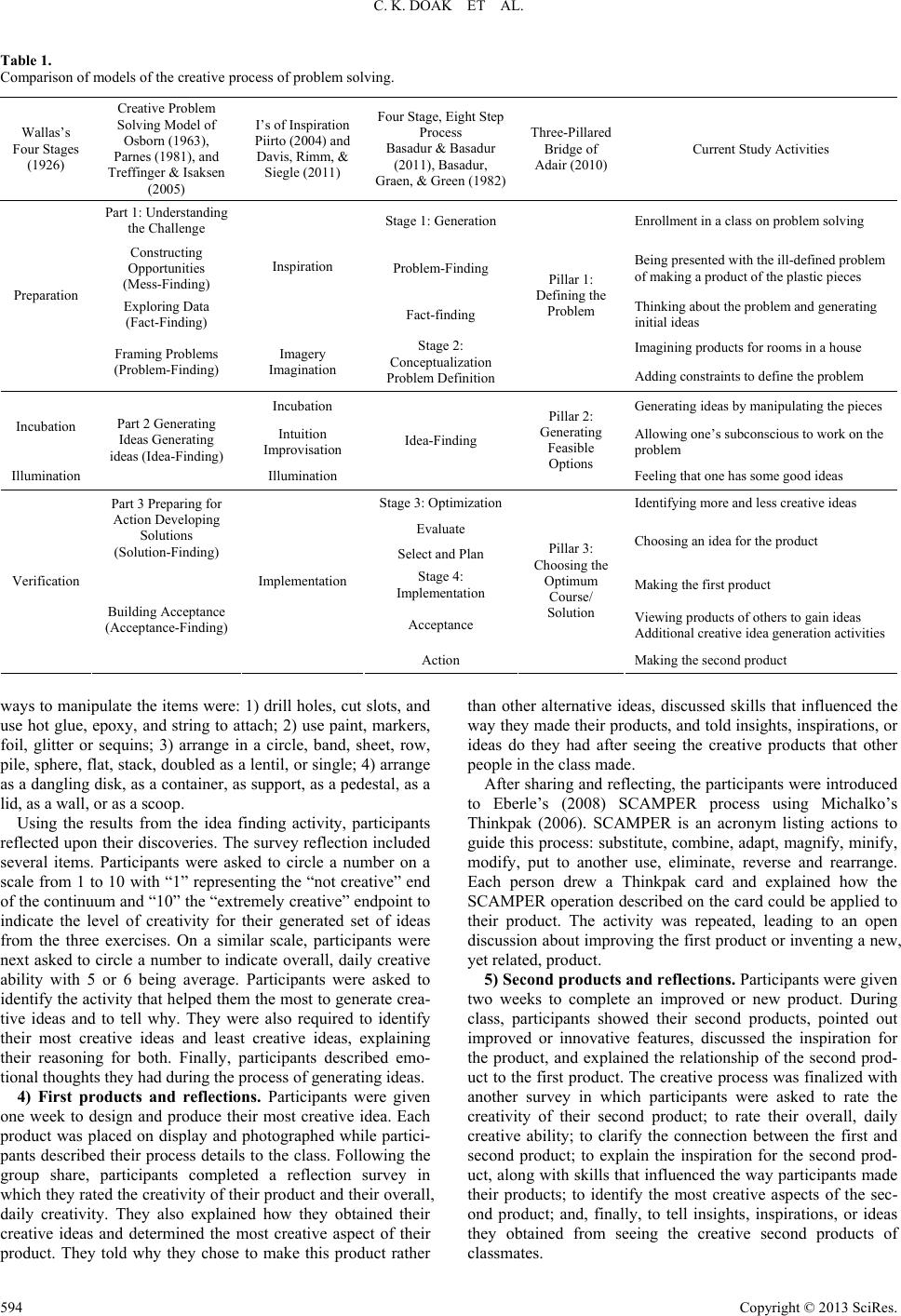 C. K. DOAK ET AL. Copyright © 2013 SciRe s . 594 Table 1. Comparison of models of the creative process of problem solving. Wallas’s Four Stages (1926) Creative Problem Solving Model of Osborn (19 63), Parnes (1981), and Treffinge r & Isaksen (2005) I’s of Inspiration Piirto (2004) and Davis, Rimm, & Siegle (2011) Four Stage, Eight Ste p Process Basadur & Basadur (2011), Basadur, Graen, & Green (1982) Three-Pillared Bridge of Adair (2010) Current Study Activities Part 1: Understanding the Challenge Stage 1: Gene r ation Enrollmen t i n a class on problem solving Constructing Opportunities (Mess-Finding) Problem-Finding Being presented with the ill- defined problem of making a product of the plastic pi eces Exploring Data (Fact-Finding) Inspiration Fact-finding Thinking a bo ut the problem and generating initial idea s Imagining p r oducts for rooms in a house Preparation Framing Pr o bl ems (Problem-Finding) Imagery Imagination Stage 2: Conceptualization Problem Definition Pillar 1: Defining the Problem Adding constraints to define the problem Incubation Generating i deas by manipulating the pieces Incubation Intuition Improvisation Allowing one’s subconscious to work on the problem Illumination Part 2 Gene r ating Ideas Gen erating ideas (Idea-Finding) Illumination Idea-Finding Pillar 2: Generating Feasible Options Feeling that one has some good ideas Stage 3: Optimization Identifying more and less creative ideas Evaluate Part 3 Preparing for Action Developing Solutions (Solution-Finding) Select and Plan Choosing an idea for the product Stage 4: Implementation Making the first product Acceptance Viewing pr o ducts of others to gain id eas Additional creative idea generation activities Verification Building Acceptance (Acceptance- Fi nd ing) Implementation Action Pillar 3: Choosing the Optimum Course/ Solution Making the second prod uct ways to manipulate the items were: 1) drill holes, cut slots, and use hot glue, epoxy, and string to attach; 2) use paint, markers, foil, glitter or sequins; 3) arrange in a circle, band, sheet, row, pile, sphere, flat, stack, doubled as a lentil, or single; 4) arrange as a dangling disk, as a container, as support, as a pedestal, as a lid, as a wall, or as a scoop. Using the results from the idea finding activity, participants reflected upon their discoveries. The survey reflection included several items. Participants were asked to circle a number on a scale from 1 to 10 with “1” representing the “not creative” end of the continuum and “10” the “extremely creative” endpoint to indicate the level of creativity for their generated set of ideas from the three exercises. On a similar scale, participants were next asked to circle a number to indicate overall, daily creative ability with 5 or 6 being average. Participants were asked to identify the activity that helped them the most to generate crea- tive ideas and to tell why. They were also required to identify their most creative ideas and least creative ideas, explaining their reasoning for both. Finally, participants described emo- tional thoughts they had during the process of generating ideas. 4) First products and reflections. Participants were given one week to design and produce their most creative idea. Each product was placed on display and photographed while partici- pants described their process details to the class. Following the group share, participants completed a reflection survey in which they rated the creativity of their product and their overall, daily creativity. They also explained how they obtained their creative ideas and determined the most creative aspect of their product. They told why they chose to make this product rather than other alternative ideas, discussed skills that influenced the way they made their products, and told insights, inspirations, or ideas do they had after seeing the creative products that other people in the class made . After sharing and reflecting, the participants were introduced to Eberle’s (2008) SCAMPER process using Michalko’s Thinkpak (2006). SCAMPER is an acronym listing actions to guide this process: substitute, combine, adapt, magnify, minify, modify, put to another use, eliminate, reverse and rearrange. Each person drew a Thinkpak card and explained how the SCAMPER operation described on the card could be applied to their product. The activity was repeated, leading to an open discussion about improving the first product or inventing a new, yet related, product. 5) Second products and ref lections. Part ici pants we re give n two weeks to complete an improved or new product. During class, participants showed their second products, pointed out improved or innovative features, discussed the inspiration for the product, and explained the relationship of the second prod- uct to the first product. The creative process was finalized with another survey in which participants were asked to rate the creativity of their second product; to rate their overall, daily creative ability; to clarify the connection between the first and second product; to explain the inspiration for the second prod- uct, along with skills that influenced the way participants made their products; to identify the most creative aspects of the sec- ond product; and, finally, to tell insights, inspirations, or ideas they obtained from seeing the creative second products of classmates. 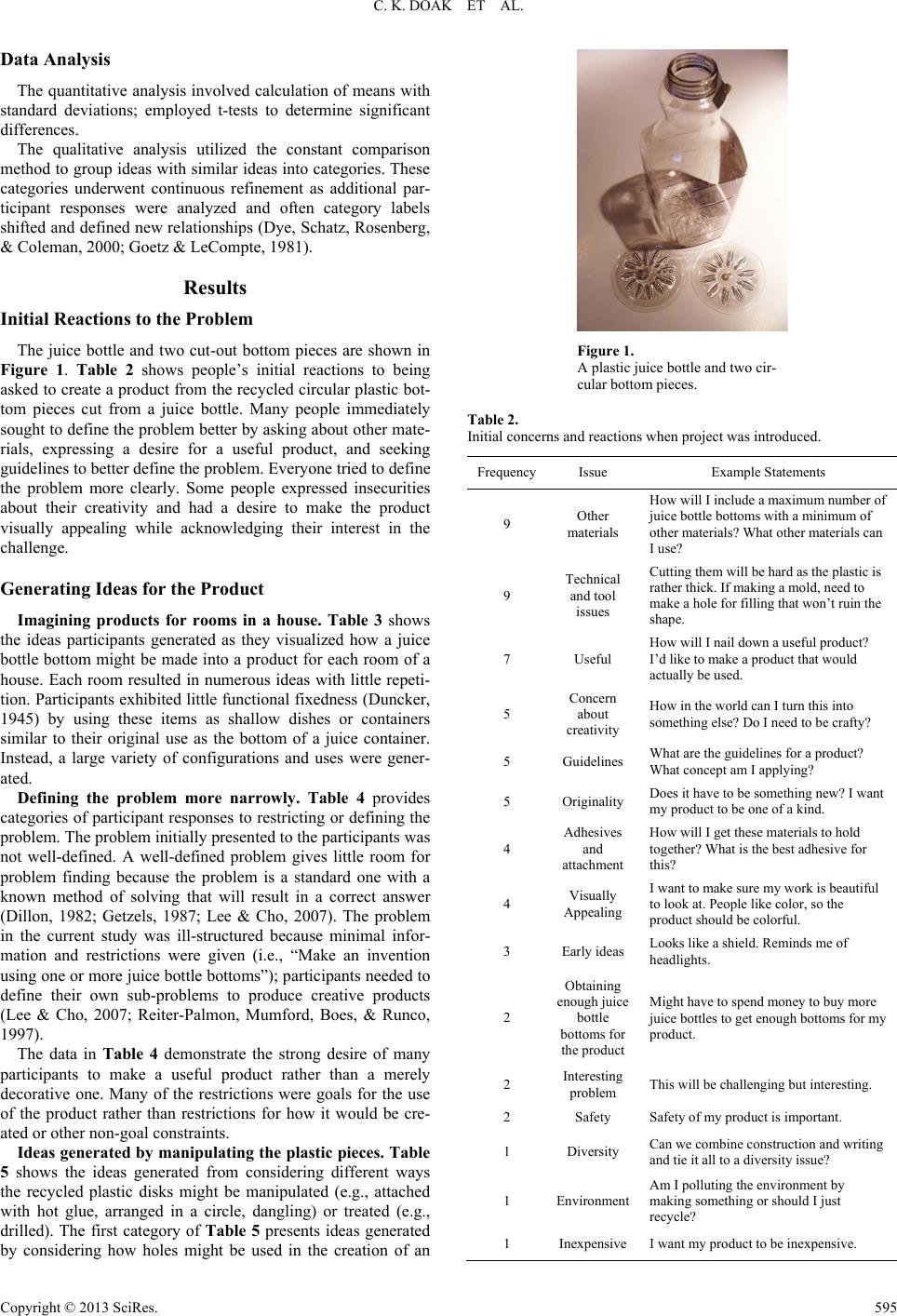 C. K. DOAK ET AL. Copyright © 2013 SciRe s . 595 Data Analysis The quantitative analysis involved calculation of means with standard deviations; employed t-tests to determine significant differences. The qualitative analysis utilized the constant comparison method to group ideas with similar ideas into categories. These categories underwent continuous refinement as additional par- ticipant responses were analyzed and often category labels shifted and defined new relationships (Dye, Schatz, Rosenberg, & Coleman, 2000; Goetz & LeCompte, 1981). Results Initial Reactions to the Problem The juice bottle and two cut-out bottom pieces are shown in Figure 1. Table 2 shows people’s initial reactions to being asked to create a product from the recycled circular plastic bot- tom pieces cut from a juice bottle. Many people immediately sought to define the problem better by asking about other mate- rials, expressing a desire for a useful product, and seeking guidelines to better define the problem. Everyone tried to define the problem more clearly. Some people expressed insecurities about their creativity and had a desire to make the product visually appealing while acknowledging their interest in the challenge. Generating Ideas for the Product Imagining products for rooms in a house. Table 3 shows the ideas participants generated as they visualized how a juice bottle bottom might be made into a product for each room of a house. Each room resulted in numerous ideas with little repeti- tion. Participants exhibited little functional fixedness (Duncker, 1945) by using these items as shallow dishes or containers similar to their original use as the bottom of a juice container. Instead, a large variety of configurations and uses were gener- ated. Defining the problem more narrowly. Table 4 provides categories of participant responses to restricting or defining the problem. The problem initially presented to the participants was not well-defined. A well-defined problem gives little room for problem finding because the problem is a standard one with a known method of solving that will result in a correct answer (Dillon, 1982; Getzels, 1987; Lee & Cho, 2007). The problem in the current study was ill-structured because minimal infor- mation and restrictions were given (i.e., “Make an invention using one or more juice bottle bottoms”); participants needed to define their own sub-problems to produce creative products (Lee & Cho, 2007; Reiter-Palmon, Mumford, Boes, & Runco, 1997). The data in Table 4 demonstrate the strong desire of many participants to make a useful product rather than a merely decorative one. Many of the restrictions were goals for the use of the product rather than restrictions for how it would be cre- ated or other non-goal constraints. Ideas generated by manipulating the plastic pieces. Table 5 shows the ideas generated from considering different ways the recycled plastic disks might be manipulated (e.g., attached with hot glue, arranged in a circle, dangling) or treated (e.g., drilled). The first category of Table 5 presents ideas generated by considering how holes might be used in the creation of an Figure 1. A plastic juice bottl e and two cir- cular bottom pieces. Table 2. Initial concerns and reactions when project was introduced. FrequencyIssue Example Statements 9 Other materials How will I include a maximum number of juice bottle bottoms with a minimum of other mate rials? What other materia ls can I use? 9 Technical and tool issues Cutting them will be hard as the plastic is rather thick. If making a mold, need to make a hole for filling that won’t ruin the shape. 7 Useful How will I nail down a useful product? I’d like to make a product that would actually be used. 5 Concern about creativity How in the world can I turn this into something else? Do I need to be crafty? 5 Guidelines What are the guideline s f o r a produc t? What concept am I applying? 5 Originality Does it have to be something new? I want my product t o be one of a kin d. 4 Adhesives and attachment How will I get these materials to hold together? What is the best a dhesive for this? 4 Visually Appealing I want to make sure my work is beautiful to look at. People like color, so the product should be colorful. 3 Early ideas Looks like a shield. Remi nds me of headlights. 2 Obtaining enough juice bottle bottoms for the product Might have t o spend money to buy more juice bottles to get enough bottoms for my product. 2 Interesting problem This will be challenging but interesting. 2 Safety Safety of my product is importa nt . 1 Diversity Can we combine const r uction and w r iting and tie it al l to a diversit y issue? 1 EnvironmentAm I polluting t he environm ent by making something or should I just recycle? 1 InexpensiveI want my produ ct to be ine xpensive. 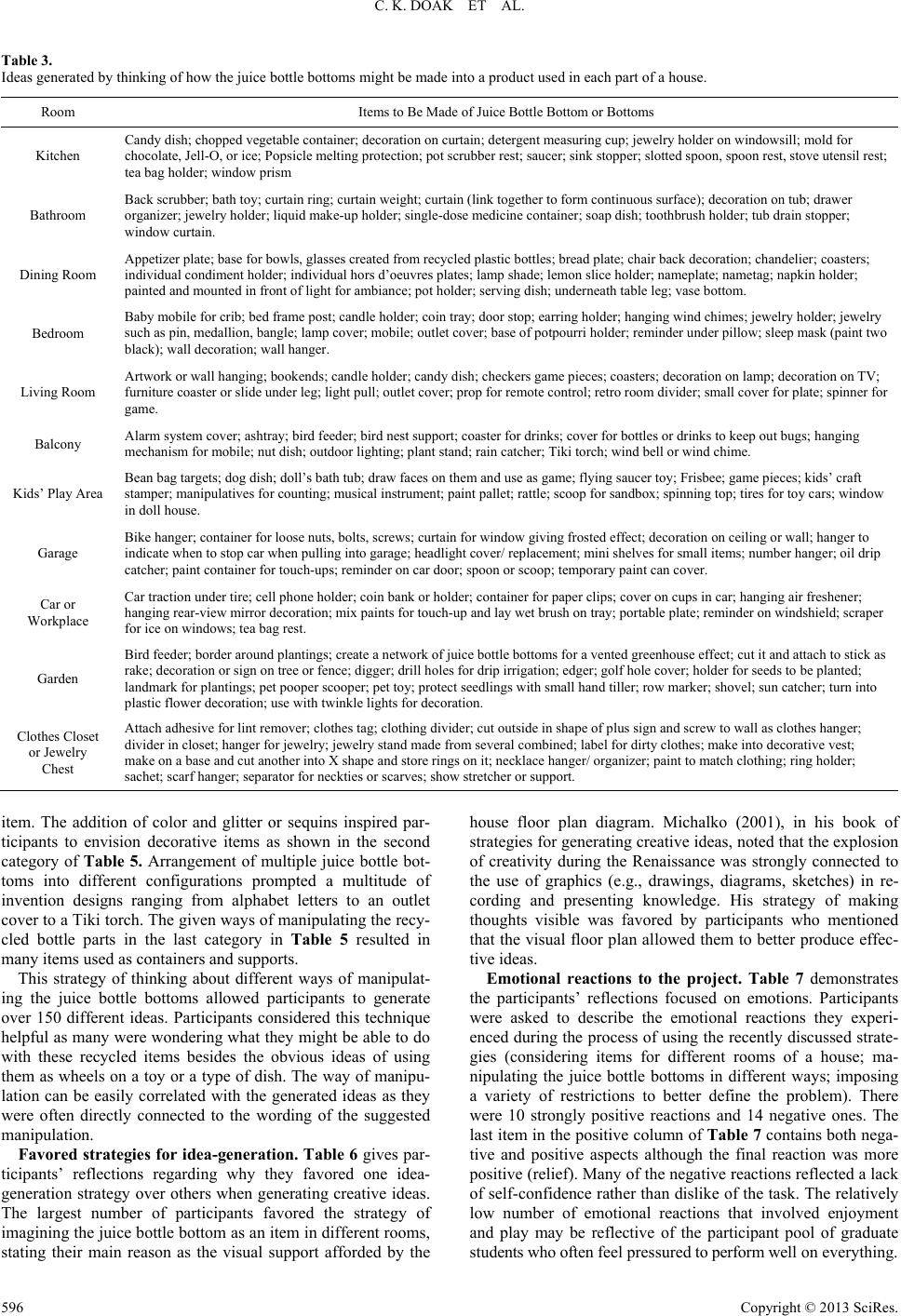 C. K. DOAK ET AL. Copyright © 2013 SciRe s . 596 Table 3. Ideas generated by thinking of how the juice bottle bottoms might be made into a product used in each part of a house. Room Items to Be Made of Juice Bottle Bott om or Bottoms Kitchen Candy dish; chopped ve getable cont ainer; decoration on c urtain; detergent measuring cup ; j ewelry hol d er on windowsill; mold for chocolate, Jell-O, or ice; Popsicle m elting protection; pot scrubber rest; saucer; sink stopper; slotted spoon, spoon rest, stove utensil rest; tea bag holder; window prism Bathroom Back scrubber; bath t oy ; curtain ring; curtain weight; curtain (link together to form continuous surface); decoration on tub; drawer organizer; jewelry holder; liq uid make-up holder; single-dose medicine container ; s oap dish; toothbrush holder; tub drain s t opper; window curtain. Dining Room Appetizer plate; base for bowls, glasses created from recycled plastic b ottles; bread plate; chair back d ecoration; chandelier; coasters; individual condiment holder; ind ividual hors d’oeuvres plates; lamp shade; lemon slice holder; n ameplate; nametag; napkin holder; painted and mounted in front of light for ambiance; pot holder; servi ng dish; underneath table leg; vase bottom. Bedroom Ba by mobile for cri b; bed frame po st; candle holder; coin tray; door stop; earring holder; hanging wind c himes; jewelry holder; jewelry such as pin, medallion, bangle; lamp cover; mobile; outlet cover; base of potpourri holder ; reminder u nder pillow; sleep mask (paint two black); wall decoration; wall hanger. Living Room Artwork or wall hanging; bookends; candle holder; candy dish; checkers game pieces; coasters; decoration on lamp; decoration on TV; furniture coaster or slide under leg; light pull; outle t cover; prop for remote control; retro room divide r; small cove r for plate; spinner for game. Balcony Alarm system cover; ashtray; bird feeder; bird nest support; c oaster for drinks; cover for bottles or drinks to keep out bugs; hanging mechanism for mobile; nut dish; outdoor lighting; plant stand; rain catcher; Tiki torch; wind bell or wind chime . Kids’ Play Area Bean bag targets; dog dish; doll’s bath tub; draw faces on them and use as game; flying saucer toy; Frisbee; game pieces; kids’ craft stamper; manipulatives for counting; music al instrum ent; paint pallet; rattle; scoop for sandbox; spinning top; tires for toy cars; window in doll house. Garage Bike hanger; container fo r loose nuts , bolts, screws; curtain for window giving frosted effect; decoration on ceiling or wall; hanger to indicate when to stop car w hen pulling into garage; headlight cover/ re placement; mini shelves for small items; number hanger; oil drip catcher; paint container for touch-ups; reminder on c ar door; spoon or scoop; temporary paint can cover. Car or Workplace Car traction under tire; cell phone holde r; coin bank or ho lder; containe r for paper c lips; cover on cu ps in car; hanging air freshener; hanging rear-view mirror decoration; mix paints for touch-up and lay wet brush on tray; portable pl ate; rem i n der on windshield; scraper for ice on windows; tea bag rest. Garden Bird feeder; border around plantin gs; create a network of juice bottle bottoms for a vente d gr eenhouse effect; cut it and attach to stick as rake; decoration or sig n o n tree or fence; digger; drill holes fo r drip irrigation; edger; golf hole cover; holder for seeds to be planted; landmark for plantings; pet pooper scooper; pet t oy; protect seedlings with small hand ti l ler; row marker ; shovel; sun catcher; turn into plastic flower decoration; use with twinkle lights for decorat ion. Clothes Closet or Jewelry Chest Attach adhesiv e for lint rem over; clothes tag; clothing divider; cut outside in shape of plus sign and screw to wa ll as clothes hanger; divider in closet; hanger for jewelry; jewelry st and made from several combined; label for dirty clot h es; make into decorative vest; make on a base and cut another into X shape and store rings on it; ne ck lace hanger/ organizer; paint to match clothing; ring holder; sachet; sca rf hanger; separator for neckties or scarves; show stretcher or support. item. The addition of color and glitter or sequins inspired par- ticipants to envision decorative items as shown in the second category of Table 5. Arrangement of multiple juice bottle bot- toms into different configurations prompted a multitude of invention designs ranging from alphabet letters to an outlet cover to a Tiki torch. The given ways of manipulating the recy- cled bottle parts in the last category in Table 5 resulted in many items used as containers and supports. This strategy of thinking about different ways of manipulat- ing the juice bottle bottoms allowed participants to generate over 150 different ideas. Participants considered this technique helpful as many were wondering what they might be able to do with these recycled items besides the obvious ideas of using them as wheels on a toy or a type of dish. The way of manipu- lation can be easily correlated with the generated ideas as they were often directly connected to the wording of the suggested manipulation. Favored strategies for idea-generation. Table 6 gives par- ticipants’ reflections regarding why they favored one idea- generation strategy over others when generating creative ideas. The largest number of participants favored the strategy of imagining the juice bottle bottom as an item in different rooms, stating their main reason as the visual support afforded by the house floor plan diagram. Michalko (2001), in his book of strategies for generating creative ideas, noted that the explosion of creativity during the Renaissance was strongly connected to the use of graphics (e.g., drawings, diagrams, sketches) in re- cording and presenting knowledge. His strategy of making thoughts visible was favored by participants who mentioned that the visual floor plan allowed them to better produce effec- tive ideas. Emotional reactions to the project. Table 7 demonstrates the participants’ reflections focused on emotions. Participants were asked to describe the emotional reactions they experi- enced during the process of using the recently discussed strate- gies (considering items for different rooms of a house; ma- nipulating the juice bottle bottoms in different ways; imposing a variety of restrictions to better define the problem). There were 10 strongly positive reactions and 14 negative ones. The last item in the positive column of Table 7 contains both nega- tive and positive aspects although the final reaction was more positive (relief). Many of the negative reactions reflected a lack of self-confidence rather than dislike of the task. The relatively low number of emotional reactions that involved enjoyment and play may be reflective of the participant pool of graduate students who often feel pressured to perform well on everything. 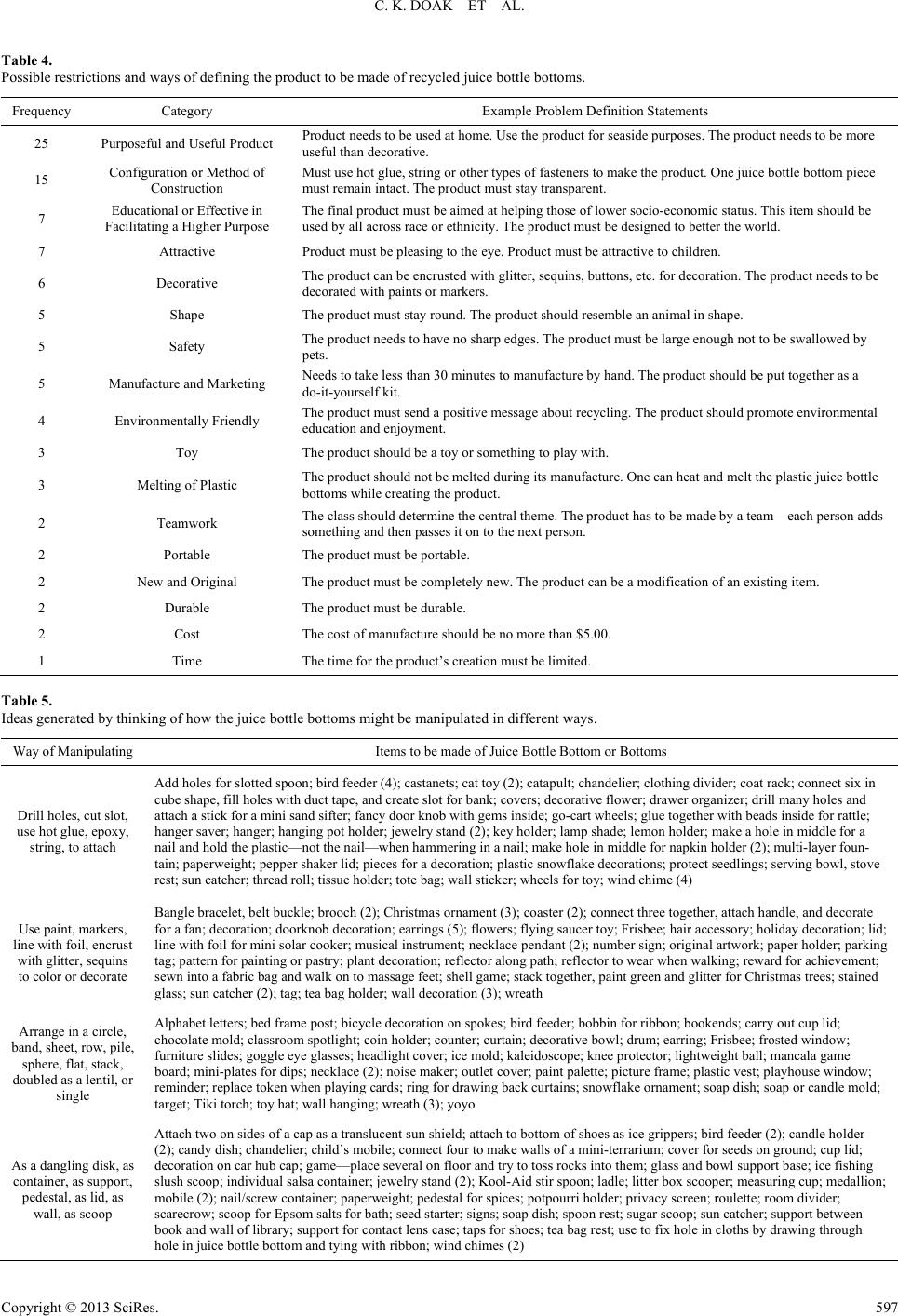 C. K. DOAK ET AL. Copyright © 2013 SciRe s . 597 Table 4. Possible restrictions and ways of defining the product to be made of recycled juice bottle bottoms. Frequency Category Example Problem Definition Statements 25 Purposeful and Useful Product Product needs to be used at home. Use th e product f or seaside pu rposes. The product needs to be more useful than decorative. 15 Configuration or Method of Construction Must use hot glu e, string o r o ther type s o f f asteners to make the product. One juice bottle bottom pi ece must remain intact. The product must stay transparent. 7 Educa t i o nal or Effective in Facilitatin g a Higher Purpo se The final product must be aimed at helping tho s e of lower socio-economic status. This item should be used by all across race or ethnicity. The product must be designed to better the world. 7 Attractive Product must be pleasing t o the eye. Product must be a ttractive to children. 6 Decorative The produc t can be encrus t ed with glitter, sequins, buttons, etc. for decoration. The product needs to be decorated with paints o r markers. 5 Shape The product must stay round. The product should resemble an animal in shape. 5 Safety The produc t n eeds to ha ve no sharp edges. Th e product must b e large enough not to be swallowe d by pets. 5 Manufacture and Marketing Needs to take less than 30 minutes to manufacture b y hand. The product should be put together a s a do-it-yourself kit. 4 Environmentally Friendly The product must send a positive m essage abo ut recycling. The product should p ro mote environmental education and e njoyment. 3 Toy The product should be a toy or something to play with. 3 Melting of Plastic The product should not be melted during its manufacture. One can heat and melt the plast i c juice bottl e bottoms while creating the product. 2 Teamwork The class sho uld dete r mine the central theme. The produc t has to be made by a team—each person adds something and then passes it on to the next person. 2 Portable The product must be portable. 2 New and Original The product must be completely new. The product can be a modification of an existing item . 2 Durable The product must be durable . 2 Cost The cost of manufacture should be no more t han $5.00. 1 Time The time for the product’s creation must be limited. Table 5. Ideas generated by thinking of how the juice bottle bottoms might be manipulated in different ways. Way of Manipul ating Items to be made of Juice Bottle Bottom or Bottoms Drill holes, cut slot, use hot glue, epoxy, string, to attach Add holes for slotted spoon; bird feeder (4); castanets; cat toy (2); catapult; cha ndelier; clothing divider; coat rack; connect six in cube shape, fill holes with duct tape, a n d create slot fo r b ank; covers; decorative flower; drawer organizer; drill many holes and attach a stick for a mini sa nd sifter; fancy door knob wit h gems inside; g o-cart wheels; glue together with beads inside for rattle; hanger saver; hanger; hanging pot holder; j ewelry stand (2); key holder; lamp shade; l emon holde r; make a hole in middle fo r a nail and hold the plastic—not the nail—when hammerin g i n a nail; make hole in middle for napkin holder (2); multi-layer foun- tain; paperweight; pepper shaker lid; pieces for a de coration; plastic snowflake decorations ; protect seedlings; servin g b owl, stove rest; sun catcher; thread roll; tiss u e holder; t o t e bag; wall sticker; wheels for toy; wi n d chime (4) Use paint, markers, line with foil, encrust with glitter, s equins to color or decorate Bangle bracelet, belt buckle; brooch (2); Christmas ornament (3); coaster (2); connect three together, attach handle, and decorate for a fan; decoration; doorknob decorati on; earrings (5); flowe rs; flying saucer toy; Frisbee ; hair accessory ; holiday de cor ation; lid; line with foil for mini solar cooker; musical instrument; necklace pendant (2); number sign; original artwork; paper holder; parking tag; pattern for painting or pastry; plan t decoration; reflector a l ong path; reflector to wear when walking; reward for achievement; sewn into a fabr i c bag and w alk on to massage fee t ; s h ell game; stack together, paint green and glitter f o r Christmas trees; stained glass; sun catcher (2); tag; tea bag holder; wall decoration (3); wreath Arrange in a circle, band, sheet, row, pile, sphere, flat, stack, doubled as a lentil, or single Alphabet letters; bed frame post; bicycl e decoration on spokes; bird feeder; bobbin for ribbon; bookends; carry out cup lid; chocolate mold; classroo m spotligh t ; coin holder; counter; curtain; decorative bowl; drum; earring; Frisbe e; frosted window; furniture slides; goggle eye glasses; headlight co ver; ice mold; kaleidoscope; knee protector; lightweight ball; mancala game board; mini-plates for dips; necklace (2); noise maker; outlet cover; paint palette; picture frame; plastic vest; playhouse window; reminder; replace token when playing cards; ring for drawing back curtains; snowflake ornament; soap dish; soap or candle mold; target; Tiki t orch; toy hat; wall hanging ; wreath (3); yoyo As a dangling disk, as container, a s support, pedestal, as lid, as wall, as sco op Attach two on sides of a cap as a translucent sun shield; at t ach to bottom of shoes as ice grippers; bird feeder (2); candle holder (2); candy dish; chandelie r; child’s mobile; connect four to make walls of a mini-terra rium; cove r for seeds on gro und; cup lid; decoration on car hub ca p; game—place several on floor and try to toss r ocks into them; glass and bowl support ba se; ice fishin g slush scoop; individual salsa container; jewelry stand (2); Kool-Aid s t ir spoon; ladle; litter bo x s cooper; measuring cup; medallion; mobile (2); nail/screw container; paperweight; pe destal for spices; potpourri holder; pr ivacy screen; roulette; room divider; scarecrow; scoop for Epsom salts for bath; seed starter; signs; soap dish; spoon rest; sugar scoop; sun catc her; support between book and wall of library; sup port for contact lens case; taps for shoes ; tea bag rest; use to fix hole i n cloths by draw ing through hole in juice bottle bottom and tying with rib bon; wind c himes (2) 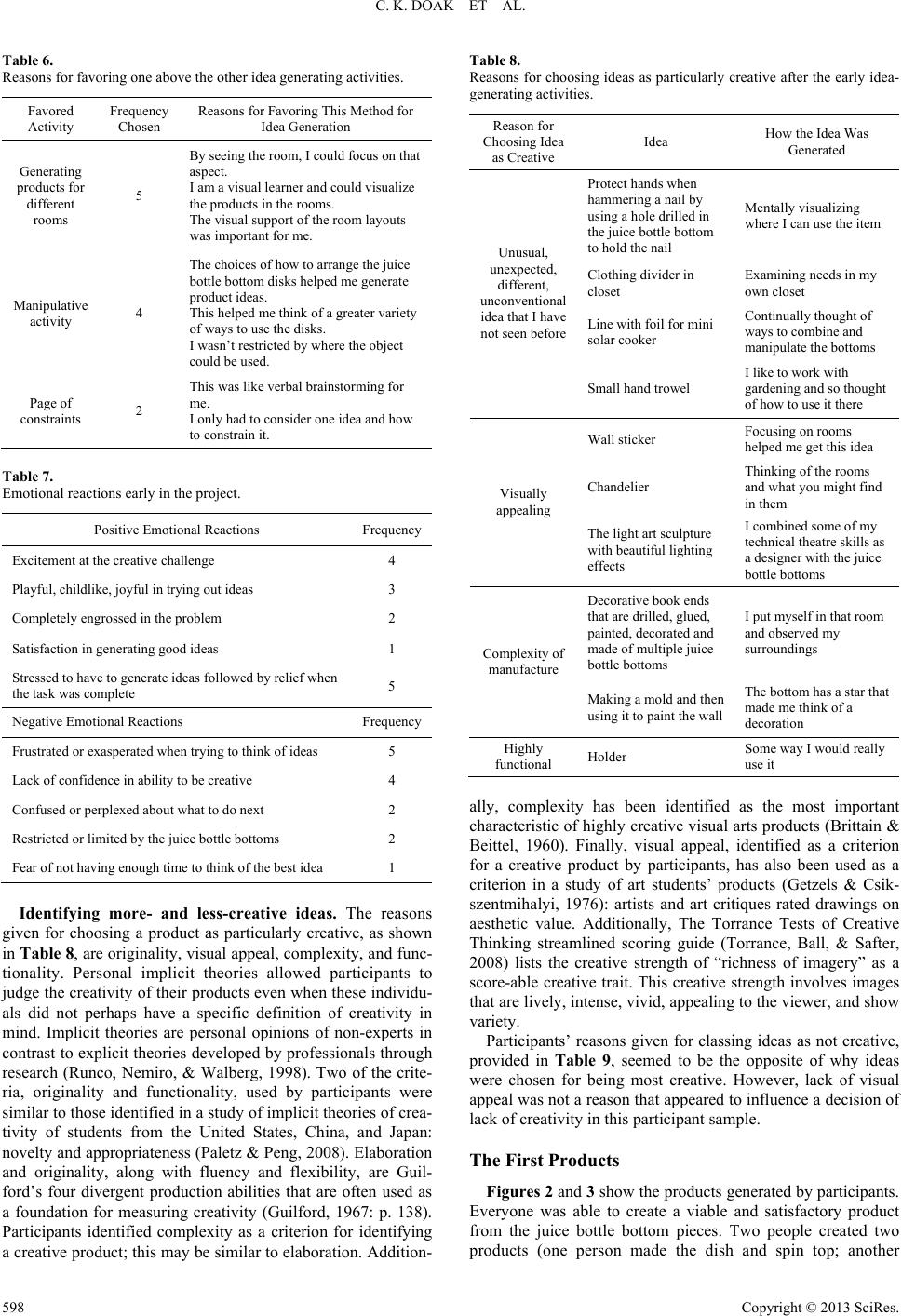 C. K. DOAK ET AL. Copyright © 2013 SciRe s . 598 Table 6. Reasons for favoring one above the other idea generating activities. Favored Activity Frequency Chosen Reasons for Favoring This Method for Idea Generation Generating products for different rooms 5 By seeing the room, I could focus on that aspect. I am a visual learner and could vis ualize the products in the rooms. The visual support of the room layouts was important for me. Manipulative activity 4 The choices of how to arrange the jui ce bottle botto m disks hel ped me generate product ideas. This helped me think of a greater variety of ways to use the disks. I wasn’t restricted by where the object could be used. Page of constraints 2 This was like verbal brainstormi ng for me. I only had to consider one idea and how to constrain it. Table 7. Emotional reactions early in the project. Positive Emotional Reactions Frequency Excitement at the creative challenge 4 Playful, childlike, joyful in trying out ideas 3 Completely engrossed in the problem 2 Satisfactio n in gene ra ting go od ide a s 1 Stressed to have to genera te ideas followed by relief when the task was complete 5 Negative Emotional Reactions Frequency Frustrated or exasperated when trying to think of ideas 5 Lack of confidence in ability to be creative 4 Confused or perplexed about what to do next 2 Restricted or limited by the juice bottle bottoms 2 Fear of not having enough time to think of the best idea 1 Identifying more- and less-creative ideas. The reasons given for choosing a product as particularly creative, as shown in Table 8, are originality, visual appeal, complexity, and func- tionality. Personal implicit theories allowed participants to judge the creativity of their products even when these individu- als did not perhaps have a specific definition of creativity in mind. Implicit theories are personal opinions of non-experts in contrast to explicit theories developed by professionals through research (Runco, Nemiro, & Walberg, 1998). Two of the crite- ria, originality and functionality, used by participants were similar to those identified in a study of implicit theories of crea- tivity of students from the United States, China, and Japan: novelty and appropriateness (Paletz & Peng, 2008). Elaboration and originality, along with fluency and flexibility, are Guil- ford’s four divergent production abilities that are often used as a foundation for measuring creativity (Guilford, 1967: p. 138). Participants identified complexity as a criterion for identifying a creative product; this may be similar to elaboration. Addition- Table 8. Reasons for choosing ideas as particularly creative after the early idea- generating activities. Reason for Choosing Idea as Creative Idea How the Idea Was Generated Protect hands when hammering a nail by using a hole drilled in the juice bottle bottom to hold the nail Mentally visu alizing where I can use the item Clothing divide r in closet Examining needs in my own closet Line with foil for mini solar cooker Continually thought of ways to combine and manipulate the bottoms Unusual, unexpected, different, unconventional idea that I have not seen before Small hand t rowel I like to work with gardening and so thought of how to use it there Wall sticker Focusing on rooms helped me get this idea Chandelier Thinking of the rooms and what y ou might find in them Visually appealing The light art sculpture with beautiful lighting effects I combined some of my technical th eatre skills as a designer with the juice bottle botto ms Decorative book ends that are drill ed, glued, painted, decorated and made of multiple juice bottle botto ms I put mysel f in t h at room and observe d my surroundings Complexity of manufacture Making a mold and then using it to paint the wall The bottom has a star that made me think of a decoration Highly functional Holder Some way I would r eally use it ally, complexity has been identified as the most important characteristic of highly creative visual arts products (Brittain & Beittel, 1960). Finally, visual appeal, identified as a criterion for a creative product by participants, has also been used as a criterion in a study of art students’ products (Getzels & Csik- szentmihalyi, 1976): artists and art critiques rated drawings on aesthetic value. Additionally, The Torrance Tests of Creative Thinking streamlined scoring guide (Torrance, Ball, & Safter, 2008) lists the creative strength of “richness of imagery” as a score-able creative trait. This creative strength involves images that are lively, intense, vivid, appealing to the viewer, and show variety. Participants’ reasons given for classing ideas as not creative, provided in Table 9, seemed to be the opposite of why ideas were chosen for being most creative. However, lack of visual appeal was not a reason that appeared to influence a decision of lack of creativity in this participant sample. The First Products Figures 2 and 3 show the products generated by participants. Everyone was able to create a viable and satisfactory product from the juice bottle bottom pieces. Two people created two products (one person made the dish and spin top; another 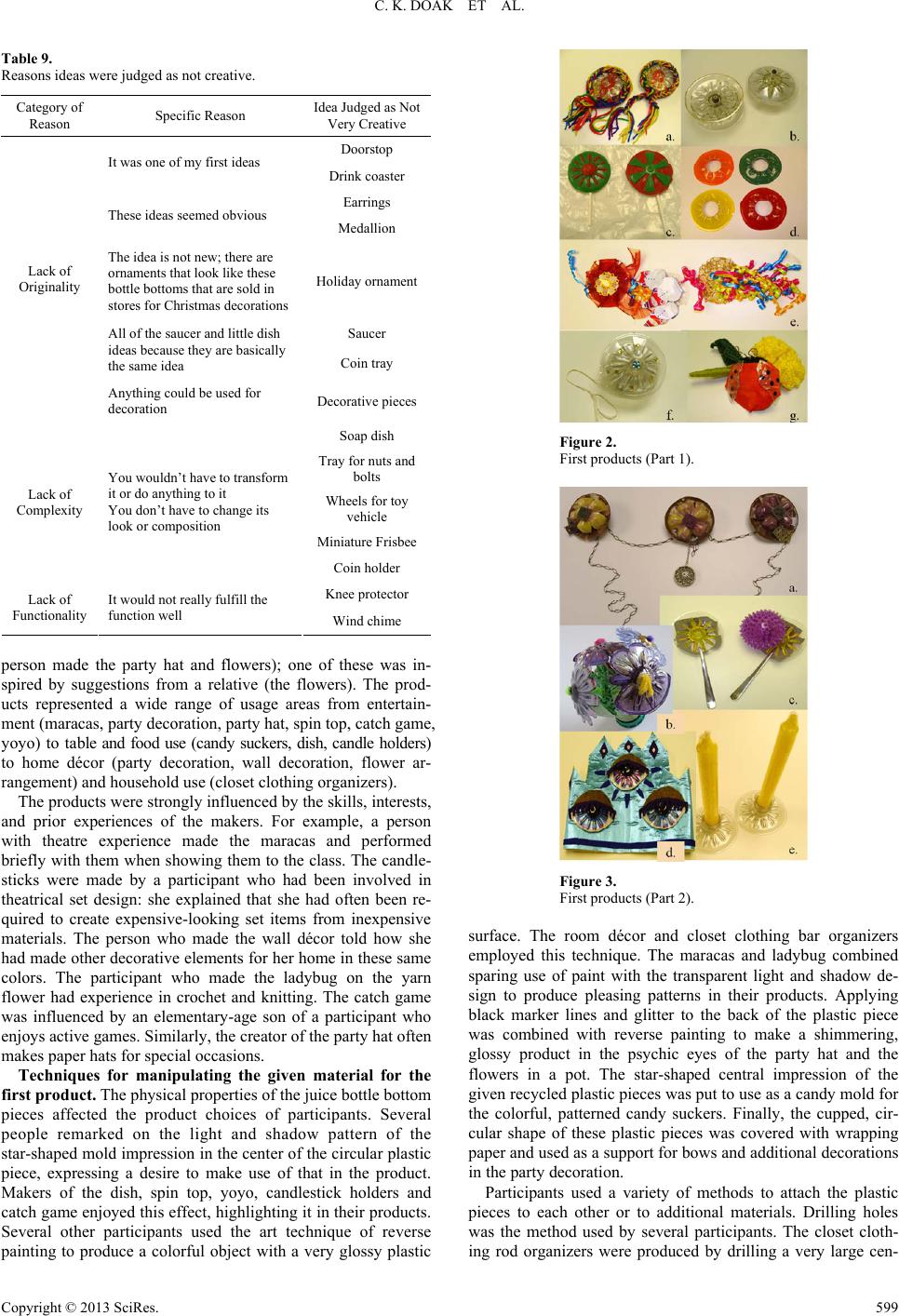 C. K. DOAK ET AL. Copyright © 2013 SciRe s . 599 Table 9. Reasons ideas were judged as not creative. Category of Reason Specific Reason Idea Judged as Not Very Creative Doorstop It was one of my first ideas Drink coaster Earrings These ideas seemed obvious Medallion The idea is not new; there are ornaments t hat look like these bottle bottoms that are sold in stores for Christmas decorations Holiday orna ment Saucer All of the saucer and litt le dish ideas because they are basically the same idea Coin tray Lack of Originality Anything c ou ld be used for decoration Decorative pieces Soap dish Tray for nuts and bolts Wheels for toy vehicle Miniature Frisbee Lack of Complexity You would n’ t h ave to transform it or do anything to it You don’t have to change its look or comp o sition Coin holder Knee protector Lack of Functionality It would not really fu l f ill the function well Wind chime person made the party hat and flowers); one of these was in- spired by suggestions from a relative (the flowers). The prod- ucts represented a wide range of usage areas from entertain- ment (maracas, party decoration, party hat, spin top, catch game, yoy o) to tab le and food use (candy suckers, dish, candle holders) to home décor (party decoration, wall decoration, flower ar- rangement) and household use (closet clothing organiz e rs). The products were strongly influenced by the skills, interests, and prior experiences of the makers. For example, a person with theatre experience made the maracas and performed briefly with them when showing them to the class. The candle- sticks were made by a participant who had been involved in theatrical set design: she explained that she had often been re- quired to create expensive-looking set items from inexpensive materials. The person who made the wall décor told how she had made other decorative elements for her home in these same colors. The participant who made the ladybug on the yarn flower had experience in crochet and knitting. The catch game was influenced by an elementary-age son of a participant who enjoys active games. Similarly, the creator of the party hat often makes paper hats for special occasions. Techniques for manipulating the given material for the first product. The physical properties of the juice bottle bottom pieces affected the product choices of participants. Several people remarked on the light and shadow pattern of the star-shaped mold impression in the center of the circular plastic piece, expressing a desire to make use of that in the product. Makers of the dish, spin top, yoyo, candlestick holders and catch game enjoyed this effect, highlighting it in their products. Several other participants used the art technique of reverse painting to produce a colorful object with a very glossy plastic Figure 2. First products (Part 1). Figure 3. First products (Part 2). surface. The room décor and closet clothing bar organizers employed this technique. The maracas and ladybug combined sparing use of paint with the transparent light and shadow de- sign to produce pleasing patterns in their products. Applying black marker lines and glitter to the back of the plastic piece was combined with reverse painting to make a shimmering, glossy product in the psychic eyes of the party hat and the flowers in a pot. The star-shaped central impression of the given recycled plastic pieces was put to use as a candy mold for the colorful, patterned candy suckers. Finally, the cupped, cir- cular shape of these plastic pieces was covered with wrapping paper and used as a support for bows and additional decorations in the party decoration. Participants used a variety of methods to attach the plastic pieces to each other or to additional materials. Drilling holes was the method used by several participants. The closet cloth- ing rod organizers were produced by drilling a very large cen- 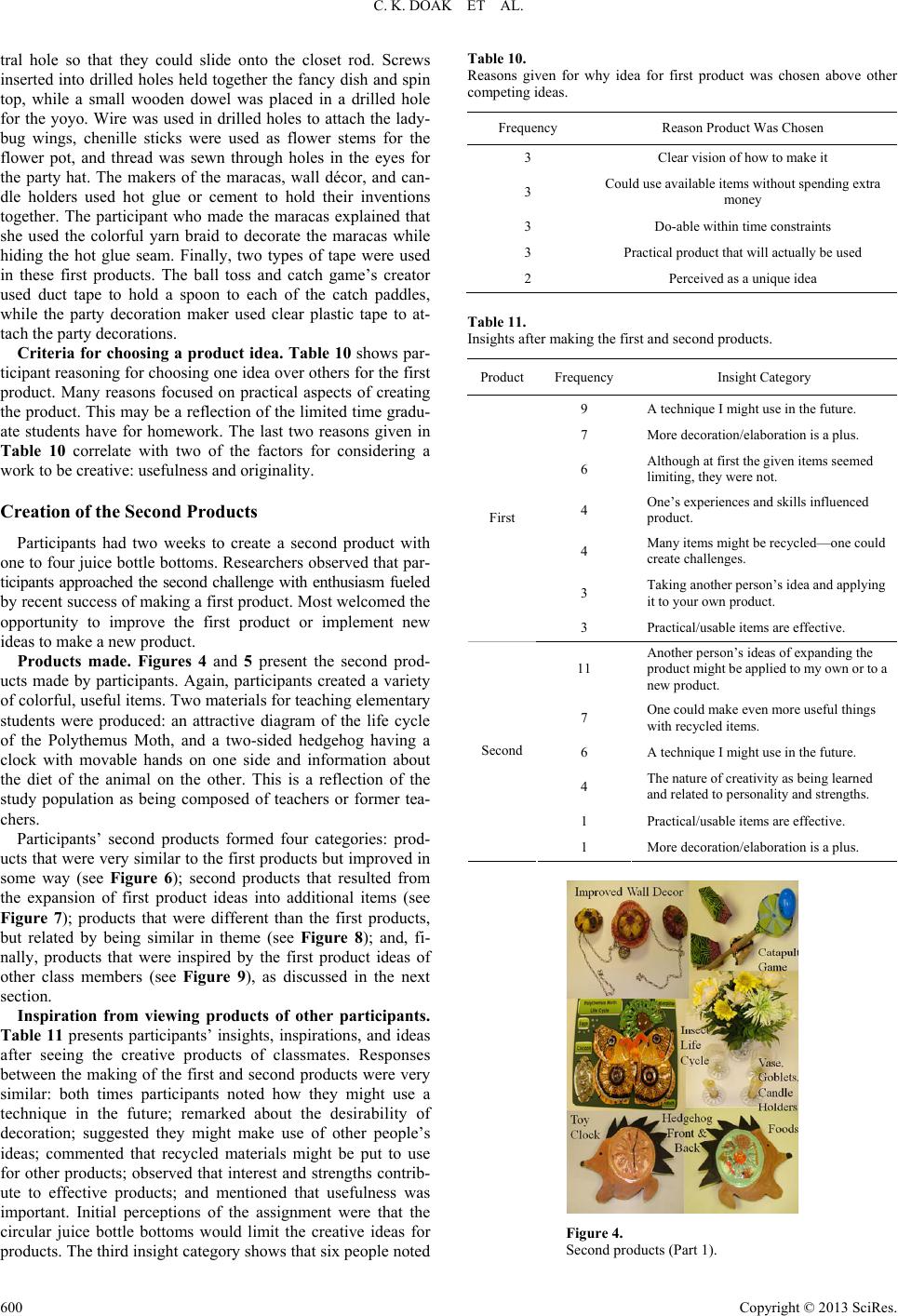 C. K. DOAK ET AL. Copyright © 2013 SciRe s . 600 tral hole so that they could slide onto the closet rod. Screws inserted into drilled holes held together the fancy dish and spin top, while a small wooden dowel was placed in a drilled hole for the yoyo. Wire was used in drilled holes to attach the lady- bug wings, chenille sticks were used as flower stems for the flower pot, and thread was sewn through holes in the eyes for the party hat. The makers of the maracas, wall décor, and can- dle holders used hot glue or cement to hold their inventions together. The participant who made the maracas explained that she used the colorful yarn braid to decorate the maracas while hiding the hot glue seam. Finally, two types of tape were used in these first products. The ball toss and catch game’s creator used duct tape to hold a spoon to each of the catch paddles, while the party decoration maker used clear plastic tape to at- tach the party decorations. Criteria for choosing a product idea. Table 10 shows par- ticipant reasoning for choosing one idea over others for the first product. Many reasons focused on practical aspects of creating the product. This may be a reflection of the limited time gradu- ate students have for homework. The last two reasons given in Table 10 correlate with two of the factors for considering a work to be creative: usefulness and originality. Creation of the Second Products Participants had two weeks to create a second product with one to four juice bottle bottoms. Researchers observed that par- ticipants approached the second challenge with enthusiasm fueled by recent success of making a first product. Most welcomed the opportunity to improve the first product or implement new ideas to make a new product. Products made. Figures 4 and 5 present the second prod- ucts made by participants. Again, participants created a variety of colorful, useful items. Two materials for teaching elementary students were produced: an attractive diagram of the life cycle of the Polythemus Moth, and a two-sided hedgehog having a clock with movable hands on one side and information about the diet of the animal on the other. This is a reflection of the study population as being composed of teachers or former tea- chers. Participants’ second products formed four categories: prod- ucts that were very similar to the first products but improved in some way (see Figure 6); second products that resulted from the expansion of first product ideas into additional items (see Figure 7); products that were different than the first products, but related by being similar in theme (see Figure 8); and, fi- nally, products that were inspired by the first product ideas of other class members (see Figure 9), as discussed in the next section. Inspiration from viewing products of other participants. Table 11 presents participants’ insights, inspirations, and ideas after seeing the creative products of classmates. Responses between the making of the first and second products were very similar: both times participants noted how they might use a technique in the future; remarked about the desirability of decoration; suggested they might make use of other people’s ideas; commented that recycled materials might be put to use for other products; observed that interest and strengths contrib- ute to effective products; and mentioned that usefulness was important. Initial perceptions of the assignment were that the circular juice bottle bottoms would limit the creative ideas for products. The third insight category shows that six people noted Table 10. Reasons given for why idea for first product was chosen above other competing ide as. Frequency Reason Product Was Chosen 3 Clear vision of how to make it 3 Could use available items without spendi ng extra money 3 Do-able within time constraints 3 Practical product that will actu ally be used 2 Perceived as a unique idea Table 11. Insights after makin g t he fi rst and second products . ProductFrequency Insight Category 9 A technique I might u se in the future. 7 More decoration/elaboration is a plus. 6 Although at first the given items s eemed limiting, they were not. 4 One’s experiences and skills influenced product. 4 Many items might be recycled—o ne could create challenges. 3 Taking another person’s idea and applying it to your own product. First 3 Practical/usable items are effec tive. 11 Another pe rson’s ideas of expanding the product mi ght be applied to m y own or t o a new product. 7 One could make even more useful things with recycled items. 6 A technique I might u se in the future. 4 The nature of creativity as being learned and related to personality and strengths. 1 Practical/usable items are effec tive. Second 1 More decoration/elaboration is a plus. Figure 4. Second products (Part 1). 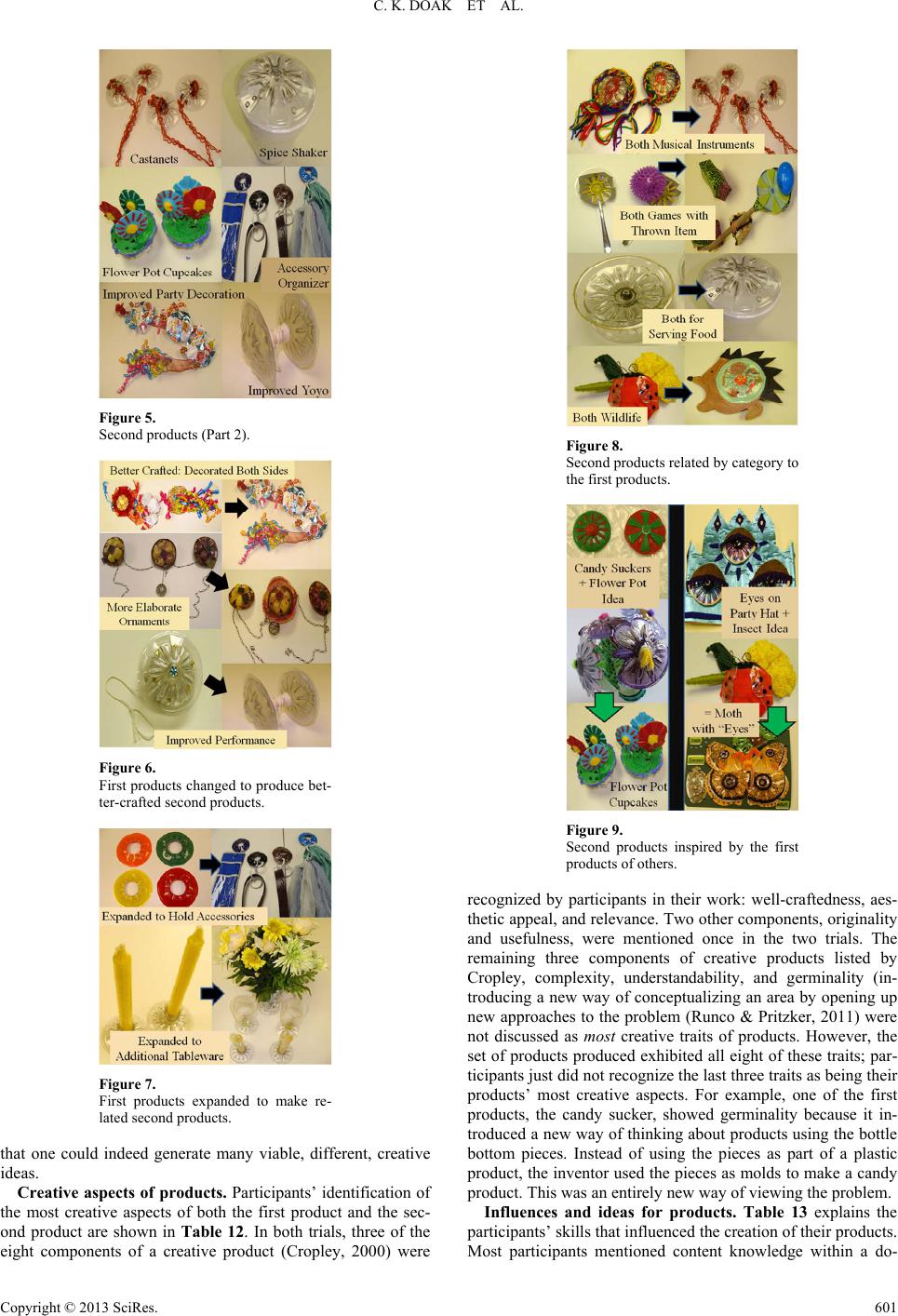 C. K. DOAK ET AL. Copyright © 2013 SciRe s . 601 Figure 5. Second products (Part 2). Figure 6. First products changed to produce bet- ter-crafted second pr o d u c t s. Figure 7. First products expanded to make re- lated second products. that one could indeed generate many viable, different, creative ideas. Creative aspects of products. Participants’ identification of the most creative aspects of both the first product and the sec- ond product are shown in Table 12. In both trials, three of the eight components of a creative product (Cropley, 2000) were Figure 8. Second products related by category to the first products. Figure 9. Second products inspired by the first products of others. recognized by participants in their work: well-craftedness, aes- thetic appeal, and relevance. Two other components, originality and usefulness, were mentioned once in the two trials. The remaining three components of creative products listed by Cropley, complexity, understandability, and germinality (in- troducing a new way of conceptualizing an area by opening up new approaches to the problem (Runco & Pritzker, 2011) were not discussed as most creative traits of products. However, the set of products produced exhibited all eight of these traits; par- ticipants just did not recognize the last three traits as being their products’ most creative aspects. For example, one of the first products, the candy sucker, showed germinality because it in- troduced a new way of thinking about products using the bottle bottom pieces. Instead of using the pieces as part of a plastic product, the inventor used the pieces as molds to make a candy product. This was an entirely new way of viewing the problem. Influences and ideas for products. Table 13 explains the participants’ skills that influenced the creation of their products. Most participants mentioned content knowledge within a do- 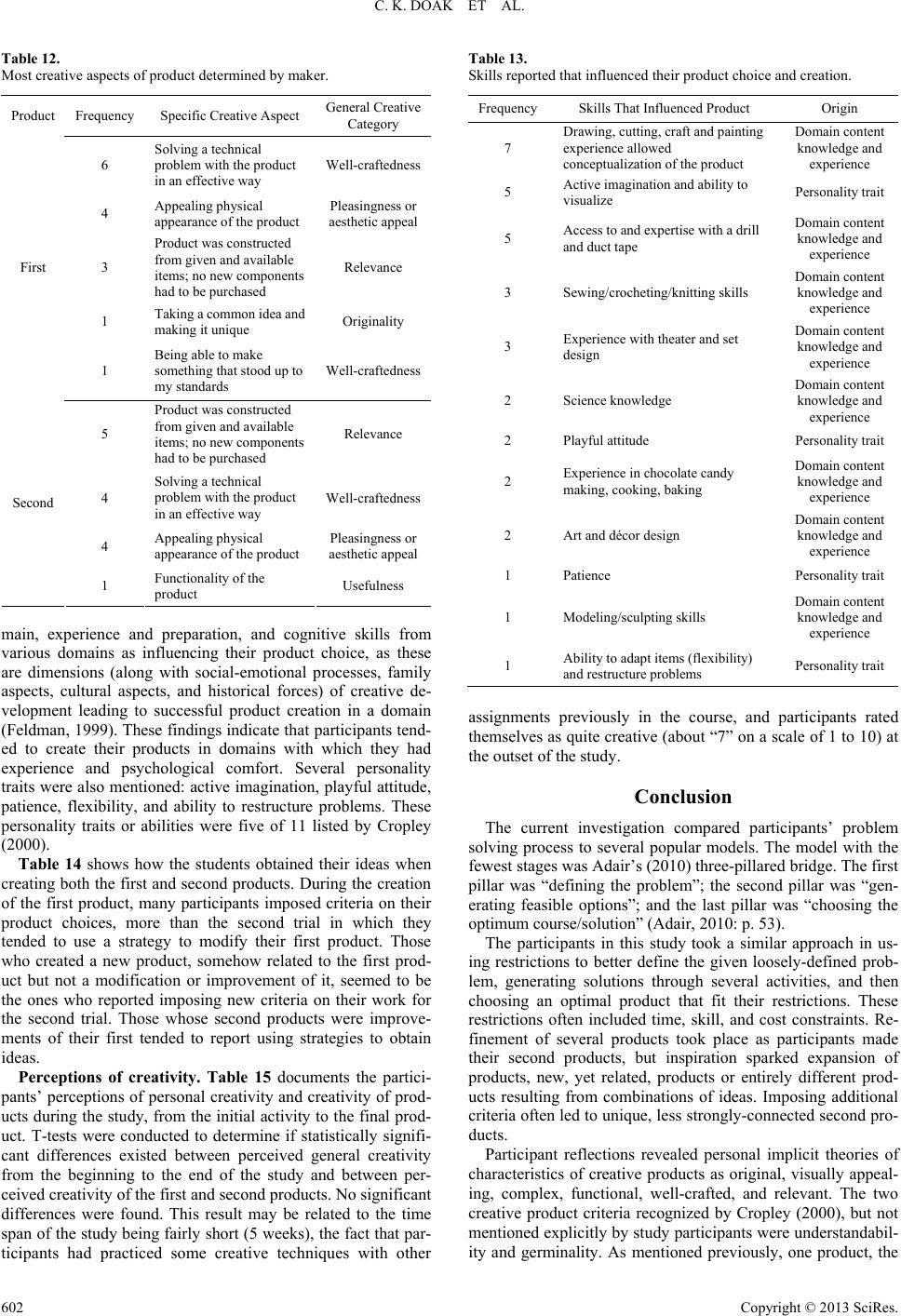 C. K. DOAK ET AL. Copyright © 2013 SciRe s . 602 Table 12. Most creative aspects of produc t de ter mined by maker. Product Frequency Specific Creative Aspect General Creative Category 6 Solving a technical problem with t he product in an effective way Well-craftedness 4 Appea ling phy sic a l appearance of the product Pleasingness or aesthetic appeal 3 Product wa s construc t ed from given and available items; no new components had to be purchased Relevance 1 T a king a co mmon ide a and making it unique Originality First 1 Being able to make something that stood up to my standards Well-craftedness 5 Product wa s construc t ed from given and available items; no new components had to be purchased Relevance 4 Solving a technical problem with t he product in an effective way Well-craftedness 4 Appea ling phy sic a l appearance of the product Pleasingness or aesthetic appeal Second 1 Functionality of the product Usefulness main, experience and preparation, and cognitive skills from various domains as influencing their product choice, as these are dimensions (along with social-emotional processes, family aspects, cultural aspects, and historical forces) of creative de- velopment leading to successful product creation in a domain (Feldman, 1999). These findings indicate that participants tend- ed to create their products in domains with which they had experience and psychological comfort. Several personality traits were also mentioned: active imagination, playful attitude, patience, flexibility, and ability to restructure problems. These personality traits or abilities were five of 11 listed by Cropley (2000). Table 14 shows how the students obtained their ideas when creating both the first and second products. During the creation of the first product, many participants imposed criteria on their product choices, more than the second trial in which they tended to use a strategy to modify their first product. Those who created a new product, somehow related to the first prod- uct but not a modification or improvement of it, seemed to be the ones who reported imposing new criteria on their work for the second trial. Those whose second products were improve- ments of their first tended to report using strategies to obtain ideas. Perceptions of creativity. Table 15 documents the partici- pants’ perceptions of personal creativity and creativity of prod- ucts during the study, from the initial activity to the final prod- uct. T-tests were conducted to determine if statistically signifi- cant differences existed between perceived general creativity from the beginning to the end of the study and between per- ceived creativity of the first and second products. No significant differences were found. This result may be related to the time span of the study being fairly short (5 weeks), the fact that par- ticipants had practiced some creative techniques with other Table 13. Skills reported that influenced their product choice and creation. Frequency Skills That Influenced P roduct Origin 7 Drawing, cutting, craft and paintin g experience allowed conceptualization of the product Domain c o ntent knowledge and experience 5 Active imagination and ability to visualize Personality trait 5 Access to and expertise w i t h a drill and duct tape Domain c o ntent knowledge and experience 3 Sewing/crocheting/knitting skills Domain content knowledge and experience 3 Experience with theater and set design Domain c o ntent knowledge and experience 2 Science kn owledge Domain content knowledge and experience 2 Playful attitude Personality trait 2 Experienc e in choco l ate candy making, cooking, baking Domain c o ntent knowledge and experience 2 Art and décor design Domain c o ntent knowledge and experience 1 Patience Personality t r ait 1 Modeling/sc ulp tin g skil ls Domain content knowledge and experience 1 Ability to adapt items ( flexibility) and restructure problems Personality t r ait assignments previously in the course, and participants rated themselves as quite creative (about “7” on a scale of 1 to 10) at the outset of the study. Conclusion The current investigation compared participants’ problem solving process to several popular models. The model with the fewest stages was Adair’s (2010) three-pillared bridge. The first pillar was “defining the problem”; the second pillar was “gen- erating feasible options”; and the last pillar was “choosing the optimum course/solution” (Adair, 2010: p. 53). The participants in this study took a similar approach in us- ing restrictions to better define the given loosely-defined prob- lem, generating solutions through several activities, and then choosing an optimal product that fit their restrictions. These restrictions often included time, skill, and cost constraints. Re- finement of several products took place as participants made their second products, but inspiration sparked expansion of products, new, yet related, products or entirely different prod- ucts resulting from combinations of ideas. Imposing additional criteria often led to unique, less strongly-connected second pro- ducts. Participant reflections revealed personal implicit theories of characteristics of creative products as original, visually appeal- ing, complex, functional, well-crafted, and relevant. The two creative product criteria recognized by Cropley (2000), but not mentioned explicitly by study participants were understandabil- ity and germinality. As mentioned previously, one product, the  C. K. DOAK ET AL. Copyright © 2013 SciRe s . 603 Table 14. Method of obtaining i de a f or product as reported by participants. Product Frequency Method of Obtaining Idea or C onstraint Category 3 Challenged myself to make something entertaining—A toy Imposed criteria 3 I connected to something I saw an d made a similar product Strategy 3 Wanted to make somet hing really different Imposed criteria 2 I challenged myself to make it all from recycled mate ri als Imposed criteria 2 I looked around my house for materials and ideas Strategy 2 Reviewed the ideas I had gene rated earlie r and my list of constraints Strategy 2 Wanted to incorporate a particular technique Imposed criteria 1 Challenged myself to make something visually appealing Imposed criteria 1 Considered problems of others and how my product might solve them Strategy 1 I decided to m ake a decorative item Imposed criteria 1 Manipulated the pieces to gain ideas Strategy First 1 The pieces played with light so I wanted to make a product using this aspect Imposed criteria 5 Desire to make a useful product Imposed criteria 3 Inspired by classmate’s product Strategy 3 Wanted to use a particular technique Imposed criteria 2 Modified original product to improve it Strategy 1 Decided to de pict a favorite a nimal Imposed criteria 1 Learne d a technique from other products Strategy 1 Manipulating the pieces helped me generate an idea Strategy 1 Saw something at home and adapted i t Strategy Second 1 Use SCAMPER Technique to gain ideas Strategy Table 15. Creativity in recent work and in general on a scale of 1 to 10 in which 1 is not creative and 10 is very creative. Mean creativi t y rating of initial ideas for possible products Mean general creativity r eported at the time of rating the initial ideas Mean creativi t y rating of the first product Mean general creativity rating at the time of first product Mean creativi t y rating of the second product Mean general creativity r eported at the time of second product 6.9 (1.6) 6.7 (1.3) 6.8 (1.5) 6.9 (0.8) 7.2 (1.8) 7.1 (1.2) Note: Standard deviations given in parentheses. candy suckers made from using the juice bottle bottoms as a mold, introduced the conception of using the given materials to manufacture the product rather than as an actual part of the final product. This candy sucker product can therefore be con- sidered as representing germinality. All products, once named, were understandable. Perhaps participants did not mention this aspect because it was assumed that the product needed to be understandable. The authors hope that this journey into the problem solving process will be useful for others as an in-depth example of how different people approached the same loosely-defined problem. All were successful in solving the problem in interesting, unique ways. The large variety of products from different cate- gories shows that participants were able to overcome functional fixedness of the circular, dish-shaped given material to generate items with many configurations and uses. Many useful insights were generated as participants approached the problem a sec- ond time and considered the inventions of classmates. Suggestions for Future Research In-depth problem solving studies such as the current study might be implemented with younger participants such as ele- mentary students to investigate differences and similarities in the process. Two notable early childhood problem-solving studies have been conducted: toddlers working with cylinders and spheres (Geiken, 2011) and first graders working with wooden block ramps and pathways for rolling marbles (Van Meeteren, 2013). Few other early childhood studies have been completed to investigate the invention process of younger chil- dren. An investigation of participants of multiple ages might reveal developmental changes in approaches. This invention problem solving project might be a good activity for residents of a retire- ment community or a mental health facility. The creative prob- lem solving process might facilitate social connections, usage of prior knowledge and skills, and a sense of satisfaction in the 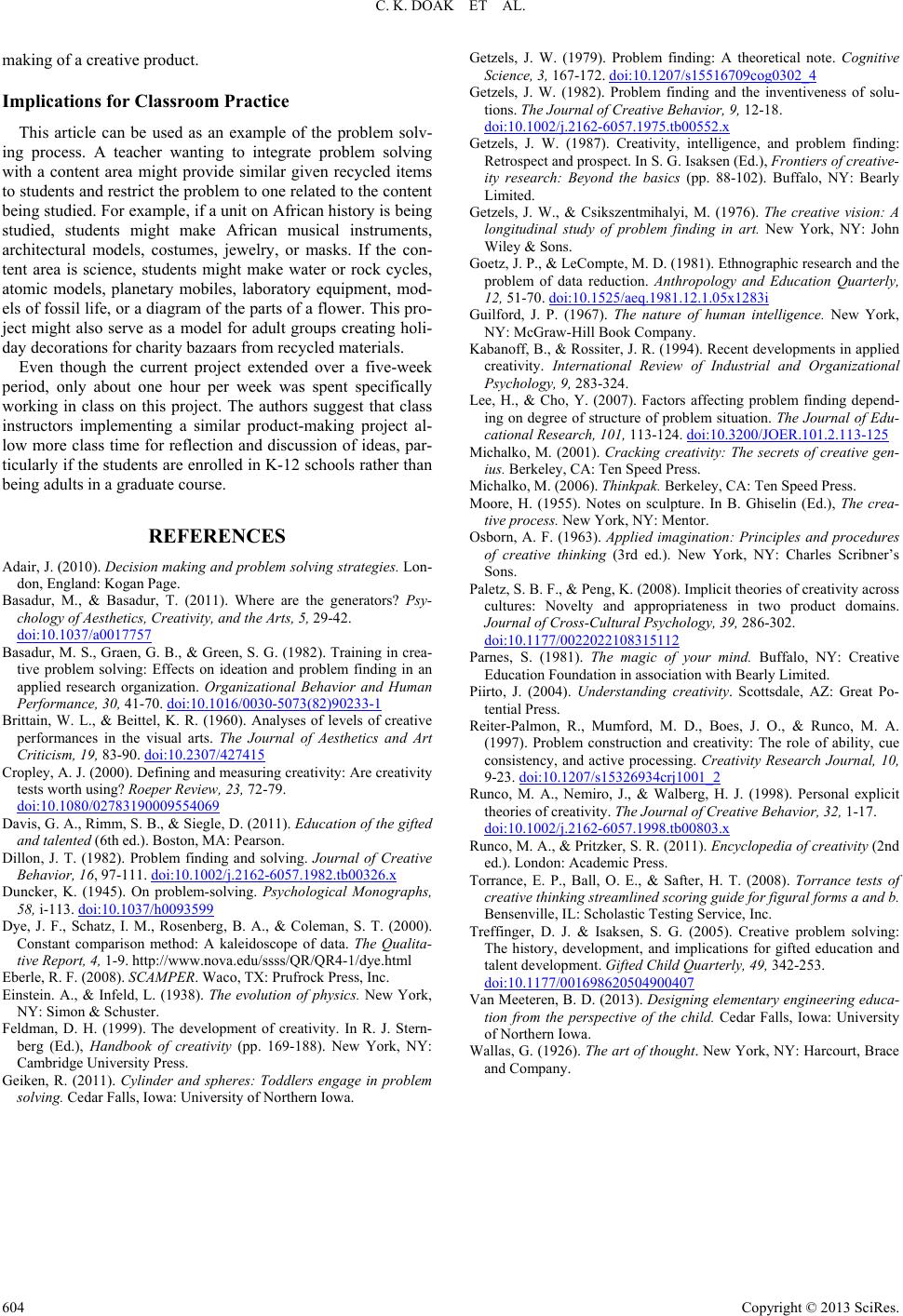 C. K. DOAK ET AL. Copyright © 2013 SciRe s . 604 making of a creative product. Implications for Classroom Practice This article can be used as an example of the problem solv- ing process. A teacher wanting to integrate problem solving with a content area might provide similar given recycled items to students and restrict the problem to one related to the content being studied. For example, if a unit on African history is being studied, students might make African musical instruments, architectural models, costumes, jewelry, or masks. If the con- tent area is science, students might make water or rock cycles, atomic models, planetary mobiles, laboratory equipment, mod- els of fossil life, or a diag ram of the parts of a flower. This pro- ject might also serve as a model for adult groups creating holi- day decorations for charity bazaars from recycled materials. Even though the current project extended over a five-week period, only about one hour per week was spent specifically working in class on this project. The authors suggest that class instructors implementing a similar product-making project al- low more class time for reflection and discussion of ideas, par- ticularly if the students are enrolled in K-12 schools rather than being adults in a graduate course. REFERENCES Adair, J. (2010). Decision making and problem solving strategies. Lon- don, England: Kogan P ag e . Basadur, M., & Basadur, T. (2011). Where are the generators? Psy- chology of Aesthetics, Creativity, and the Arts, 5, 29-42. doi:10.1037/a0017757 Basadur, M. S., Graen, G. B., & Green, S. G. (1982). Training in crea- tive problem solving: Effects on ideation and problem finding in an applied research organization. Organizational Behavior and Human Performance, 30, 41-70. doi:10.1016/0030-5073(82)90233-1 Brittain, W. L., & Beittel, K. R. (1960). Analyses of levels of creative performances in the visual arts. The Journal of Aesthetics and Art Criticism, 19, 83-90. doi:10.2307/427415 Cropley, A. J. (2000). Defining and measuring creativity: Are creativity tests worth using? Ro eper Revie w, 23, 72-79. doi:10.1080/02783190009554069 Davis, G. A., Rimm, S. B., & Siegle, D. (2011). Education of the gifted and talented (6th ed.). Boston, MA: Pearson. Dillon, J. T. (1982). Problem finding and solving. Journal of Creative Behavior, 16, 97-111. doi:10.1002/j.2162-6057.1982.tb00326.x Duncker, K. (1945). On problem-solving. Psychological Monographs, 58, i-113. doi:10.1037/h0093599 Dye, J. F., Schatz, I. M., Rosenberg, B. A., & Coleman, S. T. (2000). Constant comparison method: A kaleidoscope of data. The Qualita- tive Report, 4, 1 -9. http://www.nova.edu/ssss/QR/QR4-1/dye.html Eberle, R. F. (2008). SCAMPER. Waco, TX: Prufrock Press, Inc. Einstein. A., & Infeld, L. (1938). The evolution of physics. New York, NY: Simon & Schuster. Feldman, D. H. (1999). The development of creativity. In R. J. Stern- berg (Ed.), Handbook of creativity (pp. 169-188). New York, NY: Cambridge University Press. Geiken, R. (2011). Cylinder and spheres: Toddlers engage in problem solving. Cedar Falls, Iowa: University of Northern Iowa. Getzels, J. W. (1979). Problem finding: A theoretical note. Cognitive Science, 3, 167-172. doi:10.1207/s15516709cog0302_4 Getzels, J. W. (1982). Problem finding and the inventiveness of solu- tions. The Journal of Creative Behavio r , 9, 12-18. doi:10.1002/j.2162-6057.1975.tb00552.x Getzels, J. W. (1987). Creativity, intelligence, and problem finding: Retrospect and prospect. In S. G. Isaksen (Ed.), Frontiers of creative- ity research: Beyond the basics (pp. 88-102). Buffalo, NY: Bearly Limited. Getzels, J. W., & Csikszentmihalyi, M. (1976). The creative vision: A longitudinal study of problem finding in art. New York, NY: John Wiley & Sons. Goetz, J. P., & LeCompte, M. D. (1981). Ethnographic research and the problem of data reduction. Anthropology and Education Quarterly, 12, 51-70. doi:10.1525/aeq.1981.12.1.05x1283i Guilford, J. P. (1967). The nature of human intelligence. New York, NY: McGraw-Hill Book Company. Kabanoff, B., & Rossiter, J. R. (1994). Recent developments in applied creativity. International Review of Industrial and Organizational Psychology, 9, 283-324. Lee, H., & Cho, Y. (2007). Factors affecting problem finding depend- ing on degree of structure of problem situation. The Journal of Edu- cational Research, 101, 113-124. 1doi:10.3200/JOER.101.2.113-125 Michalko, M. (2001). Cracking creativity: The secrets of creative gen- ius. Berkeley, CA: Ten Speed Press. Michalko, M. ( 200 6). Thinkpak. B er keley, CA: Ten Speed Press. Moore, H. (1955). Notes on sculpture. In B. Ghiselin (Ed.), The crea- tive process. New York, NY: Mentor. Osborn, A. F. (1963). Applied imagination: Principles and procedures of creative thinking (3rd ed.). New York, NY: Charles Scribner’s Sons. Paletz, S. B. F., & Peng, K. (2008). Implicit t h e o ries of creativity across cultures: Novelty and appropriateness in two product domains. Journal of Cross-Cul tural Psychology, 3 9, 286-302. doi:10.1177/0022022108315112 Parnes, S. (1981). The magic of your mind. Buffalo, NY: Creative Education Foundation in association with Bearly Limited. Piirto, J. (2004). Understanding creativity. Scottsdale, AZ: Great Po- tential Press. Reiter-Palmon, R., Mumford, M. D., Boes, J. O., & Runco, M. A. (1997). Problem construction and creativity: The role of ability, cue consistency, and active processing. Creativity Research Journal, 10, 9-23. doi:10.1207/s15326934crj1001_2 Runco, M. A., Nemiro, J., & Walberg, H. J. (1998). Personal explicit theories of creativity. The Journal of Creative Behavior, 32, 1-17. doi:10.1002/j.2162-6057.1998.tb00803.x Runco, M. A., & Pritzker, S. R. (2011). Encyclopedia of creativity (2nd ed.). London: Academic Press. Torrance, E. P., Ball, O. E., & Safter, H. T. (2008). Torrance tests of creative thinking streamlined scoring gui de f or f ig ura l forms a and b. Bensenville, IL: Scholastic Testing Service, Inc. Treffinger, D. J. & Isaksen, S. G. (2005). Creative problem solving: The history, development, and implications for gifted education and talent development. Gifted Child Quarterly, 49, 342-253. doi:10.1177/001698620504900407 Van Meeteren, B. D. (2013). Designing elementary engineering educa- tion from the perspective of the child. Cedar Falls, Iowa: University of Northern Iowa. Wallas, G. (1926). The art of thought. New York, NY: Harcourt, Brace and Company.
|